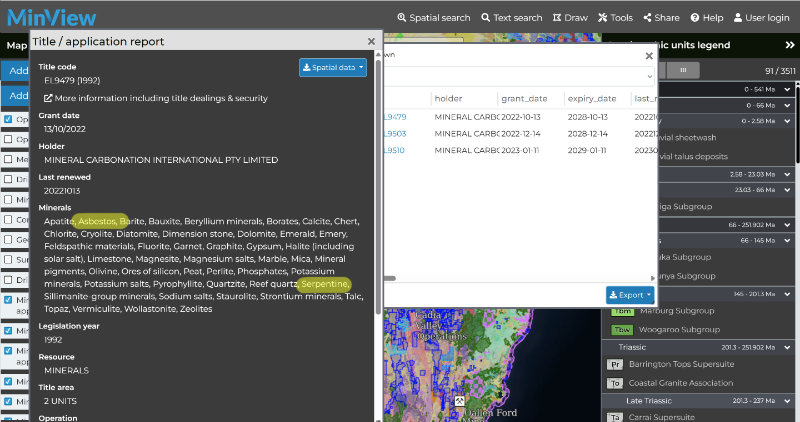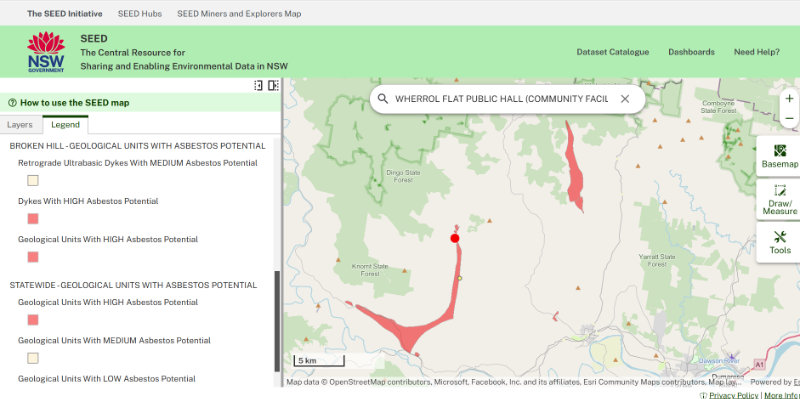Residents of the Manning Valley in NSW are raising concerns about foreign-owned companies’ plans to extract serpentine ore for carbon capture and storage, risking the release of asbestos dust. Kim Wingerei reports.
Article updated March 19 following comments from MCI Carbon.
Although it is early days, the potential scale of a future mine concerns Ian Barbour and other residents of Mount George, a likely site for a mining operation, “Our valley is mainly farming and tourism-based, and we do not want another Hunter Valley on the Manning River, one of the only delta rivers in the southern hemisphere.”
The risk of asbestos dust contamination is an added concern, and while the Federal Government has signed up for the world-wide ban on asbestos, the NSW Government has given the green light to MCI Carbon to conduct exploratory drilling in areas known to contain asbestos.
The much-debated use of Carbon Capture and Storage/Utilisation (CCS/CCU) to help reduce greenhouse gas emissions is at the heart of the exploration license granted to the Newcastle (NSW) based company.
The University of Newcastle is a research partner, and MCI has an illustrious list of multi-national shareholders, including explosives supplier Orica, London-based multinational mining company RHI Magnesita, and a slew of Japanese banks and trading houses.
In July 2024, MCI was given a Federal Government grant of $14.5m from the Carbon Capture Technologies Program (CCTP) to “to produce building materials from carbon dioxide released during cement production.” Since then, Mitsubishi UBE Cement Corporation (MUCC) has invested US$5m in the company.
In 2022 and 2023, MCI was granted exploration licenses by NSW Resources to explore for minerals in several areas west of Taree in the Manning Valley. The company also holds exploration licenses in areas west of Bathurst.
MCI Carbon and its backers are specifically looking to explore Serpentine rock for use in the decarbonisation process. Serpentine rock commonly contains chrysotile asbestos.

Extract of license details from minview.geoscience.nsw.gov.au
Carbon capture and asbestos
Mineral carbonation is a type of Carbon Capture. It involves converting CO2 into forms that can be buried, and in doing so removes the CO2 from the atmosphere. In scientific terms, mineral carbonation refers to the fixation of carbon dioxide (CO2) using alkaline and alkaline-earth oxides, such as calcium oxide (CaO) and magnesium oxide (MgO) into CaCO3 and MgCO3.
Pure calcium and magnesium oxide minerals are rare in nature, but abundant quantities of minerals containing these oxides can be found in rocks such as serpentinites.
MCI needs serpentine ore, which contains asbestos, to successfully remove CO2 from the atmosphere.
According to the Australian Government’s Asbestos Safety website, “Chrysolite Asbestos was banned in Australia in 2003 due to its known cancer-causing properties.”
However, internationally, there have been attempts to diminish the dangers of chrysotile asbestos to support the ongoing mining of chrysotile and the manufacture of asbestos-containing products. This has led to its continued use as a building material in some low and middle-income countries in the false belief that it can be used safely.
Bruce Robertson, an independent energy industry analyst who lives in the Manning Valley says, “It would seem that NSW has become a ‘low and middle-income country’ as using serpentine with a high probability of containing asbestos in building products is one of MCI carbon’s aims.”
A 2019 research paper states “MCi’s project has primarily been studying the carbonation of serpentine, which is an abundant mineral in New South Wales … It is believed that the future feedstock supply needs will be available on the gigatonne scale.”
Potential giant mining operation
MCI is working with Orica and others in an initiative to “to eliminate at least 567,000t CO2e per year from the site’s operations and 11 per cent of Australia’s total chemical industry process emissions.” MCI Carbon disputes this report, see note below.
That is a commendable goal, of course, but to achieve that, an estimated “1.6 to 3.7 tonnes of ore (depending on the magnesium content of the ore) are typically required to fix one tonne of CO2.” According to Ian Barbour, the project would “require between 900,000 and 2 million tonnes of serpentine ore to meet their stated goals, yearly.”
To put that in perspective, 2 million tonnes of ore equates to approx. 17,000 triple road train truckloads every year, or 50 road trains a day rolling down the valley.
Bruce Robertson adds that any mining operation in the Manning Valley must also account for an uncontained river that floods regularly and suddenly, with peaks up to 8 meters. “With the water catchment at the bottom end, it also means the risk of drinking water contamination from a mine site up-river is very high,” Robertson said.
Both Barbour and Robertson attended a recent ‘town hall’ meeting called to discuss the MCI project’s impact on the community, attracting more than 400 people.
Asbestos risk
Similar to Hunter Valley coal mines, the extraction of serpentine rock means surface mining.
Despite the global ban on asbestos that Australia has signed up for, MCI Carbon’s exploration license specifically names asbestos as one of the minerals, and there are no special conditions referring to the risk of asbestos contamination when extracting serpentine ore.
The asbestos safety website says, “It has been proven that all forms of asbestos, including chrysotile, cause asbestosis, mesothelioma and cancers of the lung, larynx and ovary. There is also evidence in humans that asbestos causes cancers of the pharynx, stomach and colorectum.”
Globally, it is estimated that 219,000 deaths annually can be attributed to occupational exposure to asbestos, and asbestos-related diseases still contribute to approximately 4000 deaths in Australia each year. Have the lessons of James Hardie been forgotten?
As Robertson says, “The Australian government supports a ban on asbestos yet the NSW government has awarded mining exploration leases in an area where there is a high asbestos potential according to the NSW government’s own data.”

Source: geo.seed.nsw.gov.au
Risk mitigation
MWM asked MCI Carbon how they plan to mitigate the risk of asbestos contamination during exploration. The company has replied,
“Serpentinite may occasionally contain Naturally Occurring Asbestos (NOA). MCi Carbon will map potential asbestos zones with drone geological surveys and conduct small-scale drilling where asbestos is unlikely to be present. Safety is our top priority, and we use best practice in geology. Everyone on our team undergoes mandatory asbestos training, which includes safe work practices and use of personal protective equipment. We use dust suppression and carefully monitor air quality. Any material leaving the site is transported in line with NSW Resources Regulator hazardous materials rules.”
The company has also published a Fact Sheet.
Editors note: On March 17, we received the following from MCI Carbon:
The referenced news article published at Energy Innovation contains false and misleading information about the partnership between MCi Carbon and Orica:
FALSE: Orica’s Kooragang Island Decarbonisation Project is an initiative designed to eliminate at least 567,000 tCO2e per year from the site’s operations and 11 per cent of Australia’s total chemical industry process emissions.
(Our demonstration plant is not designed to do any of this – MCi Carbon’s demonstration plant ‘Myrtle’ will capture and transform ~2000 tCO2e per year from Orica’s Kooragang Island manufacturing site. This amount will not meaningfully contribute to reducing Orica’s emissions or Australia’s total chemical industry process emissions – but will instead further validate MCi Carbon’s technology.)
FALSE: The MCi Carbon tertiary catalyst abatement technology being installed at the facility is an Australian first and is expected to reduce the site’s total emissions by 48 per cent. The cumulative emissions reduction will be at least 4.7 MtCO2e by 2030 based on forecast production.
(MCi Carbon does not specialise in tertiary catalyst abatement technology, we specialise in mineral carbonation.)
Carbon capture con. Giant Gorgon project captures less emissions than ever
Kim Wingerei is a businessman turned writer and commentator. He is passionate about free speech, human rights, democracy and the politics of change. Originally from Norway, Kim has lived in Australia for 30 years. Author of ‘Why Democracy is Broken – A Blueprint for Change’.

